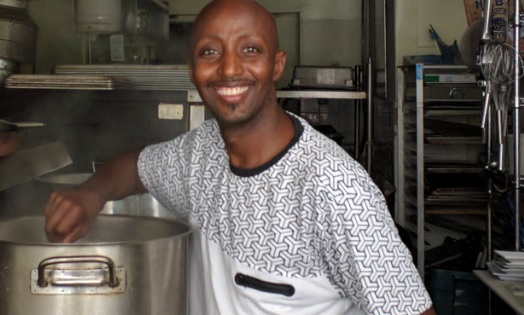
Bashir Munye explores interculturalism in the kitchen.
Munye considers his dumplings—sometimes made in the Ukrainian or Polish style, sometimes in the Chinese style, sometimes in the Italian style—to be Toronto-inspired, a tribute to his adopted city’s wide-ranging multiculturalism.
Dumplings are what multiculturalism is about—humble, filling, low-cost people’s food, made and beloved in one form or another in almost every cuisine in the world.
We are all the same under the skin and under the pastry.
But now, Munye wants to explore his own very different roots and become an African-inspired chef.
“Dumplings are part of a dialogue about the similarities we share in our diversity,” he says. “But I want to go beyond being the African guy who makes dumplings. I need to cook what’s authentic to my own experience.”
He’s still in the thick of discovering his own identity and opening his first-ever very own kitchen, successfully crowdfunded thanks to farmers’ market fans and well-wishers.
 Munye was still in the process of moving in to his own digs in Toronto’s east end, at the corner of Queen and Greenwood, when I met him for dumplings and an interview last week.
Munye was still in the process of moving in to his own digs in Toronto’s east end, at the corner of Queen and Greenwood, when I met him for dumplings and an interview last week.
I parked myself on a stool behind the kitchen counter and nibbled on a plate of chicken dumplings with a generous overlay of Harissa hot sauce (this popular hot sauce hails from Tunisia), while Munye answered my questions and started working on over 600 dumplings he had to prepare for a wedding party of 220 people later that day.
“I want to become an African chef who can showcase the beauty, contribution, and relevance of African food around the world,” he says, pausing for a moment from stirring his giant pot. “Our youth don’t have enough beautiful symbols of the continent they come from. My purpose is to provide cultural nutrients. Just as the body needs Vitamins A, B, C, and D, our minds and souls need cultural nutrients.”
He passed me a delicious and cool Sudanese drink—made from hibiscus flowers, ginger, cinnamon, and cloves—and explained the two obstacles to spreading Africa’s cultural nutrients to a new generation.
One is that the stature of African food in Canada, as with most of the world, is indelibly associated with an unrelenting series of drought- and war-induced famines since the 1970s: all dramatized by photojournalists’ displays of mothers and children dying from starvation. For children of the African diaspora living in Canada, thinking of what they will eat and cook for themselves and others when they grow up, this does not present an inspiring image or branding.

Second is the difficulty of getting hold of high-quality, reasonably priced African ingredients in Canada.
Overcoming both barriers is at the heart of Munye’s project, which I would describe as shifting Canada’s discussion about multi-racial nationhood from multiculturalism to interculturalism. In a nutshell, multiculturalism respects differences among distinct cultures and does not insist on assimilation. By comparison, interculturalism actively embraces, shares, and learns from the diversity of cultures—as in fusion foods.
Toronto has an unparalleled opportunity to become intercultural, and chefs such as Munye can lead us in that journey.
The first barrier—the low stature of African cuisine, most often depicted as thin gruel in emergency camps—takes just a bit of research to deal with.
According to Joan Baxter, arguably the most seasoned and informed Canadian reporter working on African agriculture and food issues, Africa cleans up in the highly respected Lancet Global Health ratings of 187 national cuisines in the world. Nine of the top 10 countries for healthful meals are in Africa, Baxter notes. Canada and the U.S. did not make the cut.
The onus for changing Africa’s sorry reputation and image falls on Canadian charities that must learn to raise emergency donations by appealing to empathy, not pity, while respecting Africa’s ability to manage its own food production over the long haul.
The second barrier is what Munye sees as his job—adaptation, not replication.
People who want to ensure continuity of Indigenous cuisines in Canada do not insist on cooking only over open fires or preserving without access to refrigerators.
Likewise, Canadian chefs preparing authentic African cuisines will, Munye says, “have to make some changes to have continuity.”
Italian food has spread globally, partly because it is easy to replicate. But African curries (east Africa was connected since Biblical times by trade winds carrying ships from Africa to India and Indonesia) take years to master and cannot be learned properly without access to elders, he says.
Aside from spices, the bent of African food heritage is part of a deep divide in global agricultural history. In temperate northern climates, dairy cows, steers, and pigs fare well in domesticated conditions.
In sub-tropical and tropical Africa, dry seasons present harsher challenges to year-round domestication of agriculture than winter does in the north. Consequently, goats, sheep, and camels, which can travel more easily to better food, are dominant meat animals. There is no Indigenous equivalent to dairy animals. And coastal fish, though they abound in the oceans off west Africa, have not been accessible because the waters are shark-infested.
But sheep and goats give a lot for chefs to work with, as do African grains such as teff and sorghum. The rest can be played with.
“Food is very fluid,” Munye says. “It’s like a river; it constantly changes direction and evolves.”
.
.
.
SOURCES: Wayne Roberts, PhD, writes about city food issues in his free weekly newsletter.
_____________________________________________________________________________________
Xafiiska Wararka Qaranimo Online | Mogadishu, Somalia
_____________________________________________________________________________________Advertisement
_____________________________________________________________________________________







